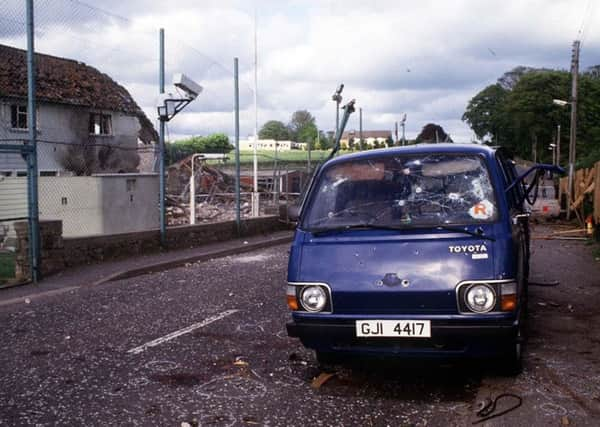Loughgall 30 years on: Military operation turned tide on terrorists


Within minutes of eight heavily armed terrorists arriving in the sleepy Co Armagh village in a digger and Toyota van, the RUC station had been severely damaged by a massive explosion, hundreds of rounds of ammunition had been fired from high velocity weapons and nine men lay dead.
Eight of those shot by the soldiers lying in wait were members of an experienced IRA gang while the ninth was passer-by Anthony Hughes who was dressed in a boilersuit similar to the ones worn by the IRA men. His brother Oliver, who was also travelling in the car, was seriously wounded.
Advertisement
Hide AdAdvertisement
Hide AdThe IRA men who died were the East Tyrone/Monaghan IRA members: Patrick McKearney, 32; Tony Gormley, 25; Jim Lynagh, 31; Patrick Kelly, 32; Declan Arthurs, 21; Gerard O’Callaghan, 29; Seamus Donnelly, 19 and Eugene Kelly, 25.
All of the terrorists were wearing body armour and their arsenal of firearms included rifles, shotguns and handguns.
The attack on Loughgall police station was a tried and tested tactic previously used to destroy the Birches RUC base – just a few miles north of Loughgall near Lough Neagh – in 1986 and Ballygawley RUC station the year previous. Two police officers were killed during the Ballygawley attack and a Ruger revolver taken from the body of Constable William Clements was recovered at the scene of the Loughgall ambush. The same gun was used in two other murders.
Advertisement
Hide AdAdvertisement
Hide AdThe weapons recovered from the scene at Loughgall had been used “in attacks as far apart as Castledawson, Portadown and Ballinamallard” the News Letter reported at the time.
In the bucket of the digger used to crash through the gates of the station was a 400lb bomb (not 200lb as widely reported). It was driven against the wall of the base by Arthurs and detonated, destroying almost half of the two-story property. This took place as the occupants of the Hiace van alighted and raked the station with automatic gunfire. Six of the eight men were later discovered to have opened fire.
As they did so, the SAS soldiers secreted in a nearby hedgerow and surrounding area responded. Inside the station, at least one of the six SAS soldiers and two HMSU (RUC specialist officers) quickly recovered from the effects of the blast and also returned fire on the terrorists. One of the RUC officers was a local neighbourhood constable who had bravely volunteered to stay in the base to create an air of normality during the covert operation.
Advertisement
Hide AdAdvertisement
Hide AdLynagh and McKearney were on-the-runs who were wanted in Northern Ireland while living freely in the border counties in the Republic - widely regarded as the driving force behind most of the IRA murders in Tyrone and beyond for more than ten years prior to their deaths at Loughgall.
The eight became known in republican circles as the ‘Loughgall Martyrs’ and their families have continued with a 30-year campaign to have the deaths deemed ‘unlawful killings’.
The position of the MOD, police and UK Government is that the men could not have been safely arrested in the circumstances.
In September 2015 the UK Government’s Advocate General for Northern Ireland, Jeremy Wright QC, decided that new inquests examining the circumstances surrounding the deaths should be held, however, the finances to conduct a large number of legacy inquests has not been made available as yet.